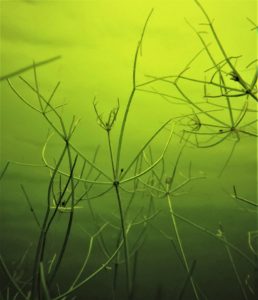Guest Blog by: Erick Elgin, Aquatic Ecologist, MSU Extension

Starry stonewort has emerged as one of the most dreaded aquatic invasive plants in Michigan. This aggressive macroalgae can produce dense “meadows” that fill the water column, which hinders recreation and may have wide-reaching impacts on lake ecosystems. However, despite being in North America for 40 years, we know very little about its biology, distribution, and ecological impacts. Further, we do not know how effective commonly used management actions (e.g., copper-based herbicides and mechanical harvesting) will be on starry stonewort.
To address these research and management needs the Starry Stonewort Collaborative was formed in 2018. Managed by the Finger Lakes Institute in New York, this collaborative brings together experts, managers, and citizen scientists from around the Great Lakes region. They are working together to better understand and control starry stonewort throughout its invaded range.
A key goal of the Starry Stonewort Collaborative is to train citizen scientists on the correct identification of this cryptic species and how to report occurrences. Identification can be difficult because there are many native look-a-likes, including Chara and Nitella species, which are very common in our lakes. By increasing the number of trained eyes on the water we will better define the extent of starry stonewort and how quickly it spreads.
The Starry Stonewort Collaborative offers newsletters, webinars, training information, and an opportunity to join as a volunteer. If you would like to learn more about Starry Stonewort or get involved, visit their website or Facebook page. I recommend starting off by watching the introductory webinar by Project Manager David Carr.
Interested in becoming a volunteer lake monitor with the Cooperative Lakes Monitoring Program?
MiCorps, Michigan’s statewide volunteer monitoring program, monitors for Starry Stonewort under our Exotic Aquatic Plant Watch (EAPW) parameter. Enrollment for the 2019 EAPW and other lake monitoring parameters has now ended, but please visit our Become a Volunteer page to learn more about the program and to register for the 2020 lake monitoring season later this fall.





